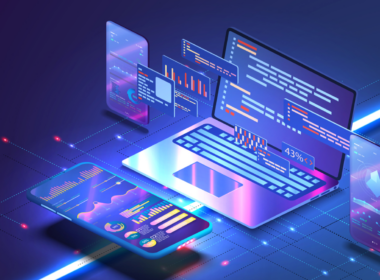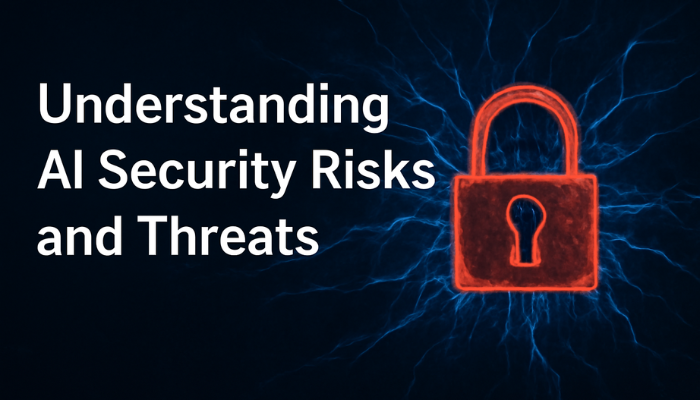AI is rapidly transforming how businesses operate. Today, over 50% of companies use AI in at least two core functions, with sales, marketing, and product development leading the way. According to McKinsey, industries across the board are planning major AI investments in the next three years.
The benefits are clear: AI streamlines processes, delivers sharper insights, and unlocks new growth opportunities. But with these advantages come serious risks. Security threats are increasing as AI becomes more embedded in day-to-day operations, and ignoring them isn’t an option.
That’s where this blog comes in. We’ll break down the biggest AI security risks you need to know, from data breaches and adversarial attacks to vulnerabilities in machine learning models. More importantly, we’ll show you how these risks could affect your business and outline practical steps you can take to safeguard your AI systems and protect your operations.
What is AI Security?
AI security refers to the protection of artificial intelligence systems, models, and data from potential threats and attacks. As businesses integrate AI into their operations, it becomes crucial to ensure that these systems remain safe from vulnerabilities that could compromise their performance, privacy, or integrity. AI security focuses on safeguarding the data used to train AI models, the models themselves, and the processes that AI systems power.
Without proper security measures in place, AI systems can be vulnerable to attacks like data poisoning, adversarial manipulation, or unauthorized access, all of which can disrupt operations and damage trust.
Also Read: Types of Software Security Audits in 2024
With that overview in mind, let’s jump right into the specific AI security risks you need to be aware of and how they can directly affect your business.
What are AI Security Risks?
As AI becomes more ingrained in modern business practices, the risks associated with it are becoming more complex and impactful. Here are the key AI security risks businesses face today, along with actionable strategies to mitigate them.
Data Privacy and Protection Risks
AI systems rely heavily on data, which can include sensitive customer information or proprietary business data. A breach or mishandling of this data could lead to privacy violations, legal repercussions, and loss of customer trust. As a leader, it’s vital to ensure that data protection measures are robust and in line with regulatory requirements like GDPR.
Model Manipulation and Adversarial Attacks
AI models can be manipulated through adversarial attacks, where small but intentional changes to input data can cause the model to make incorrect predictions. This type of risk is especially concerning for industries like finance or healthcare, where decision accuracy is critical. Leaders need to prioritize measures to detect and mitigate these attacks.
Bias in AI Models
AI systems learn from data, and if the data used to train them is biased, the AI will inherit those biases. This can result in unfair decision-making, especially in recruitment, lending, or law enforcement applications. It’s essential to regularly audit AI models and ensure they are trained on diverse, representative datasets to minimize bias.
Lack of Transparency (Black Box Problem)
Many AI models, especially deep learning systems, are complex and operate as “black boxes.” This means they make decisions without clear explanations. A lack of transparency can be problematic, especially when you need to explain or justify AI decisions to stakeholders or customers. Ensuring some level of interpretability in AI models should be a top priority for leaders.
Security Vulnerabilities in AI Software
AI systems can have software vulnerabilities that are often overlooked during development. Hackers can exploit these weaknesses to gain unauthorized access or disrupt system functionality. Leaders must ensure that AI systems are regularly updated and patched to guard against these vulnerabilities.
AI System Failures and Downtime
AI systems can fail, especially if they are not adequately trained or tested under real-world conditions. These failures can lead to costly downtime and disrupt critical operations. Implementing proper testing procedures and fallback mechanisms is key to minimizing operational impact.
Ethical and Legal Risks
The more AI systems are integrated into decision-making processes, the greater the ethical concerns become. Issues like AI-driven surveillance, privacy violations, or automated job displacement need to be carefully considered from a legal and moral standpoint. Leaders must navigate these risks with thoughtful governance and clear ethical guidelines.
Now that we’ve covered the key risks, let’s talk about how you can actually protect your AI systems. After all, no one wants to leave their business vulnerable.
Also Read: AI Cybersecurity: Role and Influence on Modern Threat Defense
Best Practices for Safeguarding AI Systems
When it comes to AI, staying secure isn’t just about having the latest tech, it’s about taking the right steps every day. Here are the best practices you need to follow to make sure your AI systems are safe, effective, and resilient:
1. Control Access to Your AI Systems
Restricting access is one of the simplest yet most powerful security measures. The fewer people who have access to sensitive AI models and data, the lower the risk of a security breach.
What You Should Do:
- Use Role-Based Access Control (RBAC): Set up different access levels depending on the role of the person. For example, only the development team may have full access, while others only have permission to interact with specific features.
- Implement Multi-Factor Authentication (MFA): This extra layer of security ensures that even if someone’s password is compromised, they can’t access the system without a second verification step, like a code sent to their phone.
- Set Permissions Based on Need: Make sure users only have access to the data and models they need for their job. The less access, the less risk of accidental misuse or intentional sabotage.
2. Keep Your Software Up to Date
Outdated software is one of the easiest targets for hackers. When vulnerabilities are found in AI tools or models, developers release patches to fix them. If you’re not updating regularly, your system could be exposed to threats that have already been patched in newer versions.
What You Should Do:
- Enable Auto-Updates: For some tools, it’s best to set up automatic updates so you don’t miss any security patches.
- Check for Updates Regularly: Even if updates aren’t automatic, ensure that you’re checking periodically for any updates or patches, especially from your AI framework providers like TensorFlow or PyTorch.
- Review the Change Log: When updates are released, always check the release notes for security fixes and any issues that might affect your model’s performance.
3. Test for Vulnerabilities
Even the most secure systems can have weaknesses. Running regular vulnerability tests will help you find any security gaps before attackers do. Think of it as checking your system for holes and patching them up before any damage is done.
What You Should Do:
- Penetration Testing: Regularly hire security professionals to perform penetration testing, this simulates an attack on your system to find weaknesses.
- Red Teaming: A more advanced method where a group mimics the actions of real-world attackers to uncover vulnerabilities in your systems.
- Automated Scanning Tools: Use automated vulnerability scanners to continuously monitor your AI systems for issues that could be exploited.
Ready to ensure flawless software and eliminate bugs for good? Partner with our offshore testing team to reduce costs, speed up testing cycles, and launch with confidence. Let’s identify the critical gaps in your systems and make your software flawless.
[Start Your Testing Journey Today]
Also Read: AI Tools for Software QA Testing in 2024
4. Secure Your Data
AI systems rely heavily on data, much of which could be sensitive. If this data is compromised, it could lead to not just security breaches, but also loss of customer trust and legal consequences. Encrypting your data ensures that even if attackers gain access to it, they can’t use it.
What You Should Do:
- Encrypt Data In Transit and At Rest: Whether your data is moving between systems or stored in a database, encryption ensures that unauthorized individuals can’t access it.
- Use Data Anonymization Techniques: For training models on sensitive data, anonymize the information so it’s harder to link back to individuals. This helps protect user privacy.
- Limit Data Collection: Only collect the data that’s necessary for your AI model to function. The less data you store, the less risk you have of data breaches.
5. Use Differential Privacy
Differential privacy is a technique that adds controlled noise to datasets, making it difficult for anyone to extract specific personal information from the data while still allowing the AI system to learn and function effectively.
What You Should Do:
- Incorporate Differential Privacy Techniques: Implement this technique during data collection or training phases to ensure the data can’t be reverse-engineered.
- Regularly Test for Privacy Leaks: Monitor models for any potential leaks that could allow sensitive information to be extracted from the model.
- Set Privacy Goals: Define clear privacy objectives, especially if your AI system uses personally identifiable information (PII).
6. Monitor AI Performance Continuously
AI models aren’t set-and-forget solutions. They require ongoing monitoring to ensure they remain secure, effective, and free from manipulation. With continuous monitoring, you can spot problems before they escalate into bigger threats.
What You Should Do:
- Real-Time Monitoring: Implement tools that provide real-time insights into how your AI systems are performing, looking for any unexpected or unusual behaviors that could indicate a security breach or malfunction.
- Model Drift Detection: AI models can change over time. Monitoring for model drift ensures that they continue to perform as expected and don’t start making decisions based on outdated or faulty data.
- Behavioral Analytics: Use advanced analytics to track model performance and identify any patterns that could signal an attack, such as sudden changes in data trends or output behavior.
7. Create an Incident Response Plan
When a security incident occurs, it’s crucial to have a clear and practiced plan to respond quickly and efficiently. The faster you can respond, the less damage an attack will do to your AI systems or your business.
What You Should Do:
- Develop a Clear Response Protocol: Create a step-by-step plan for responding to breaches, from detection to containment to recovery.
- Assign Roles and Responsibilities: Make sure everyone on your team knows their role in the event of an AI-related security breach.
- Test Your Plan Regularly: Practice drills and simulations to ensure that when a real incident happens, your team is ready to act swiftly and effectively.
8. Train Your Team on AI Security
AI security isn’t just the responsibility of the IT department, it’s a shared responsibility across your organization. Making sure your team understands the risks and how to act is essential for preventing breaches.
What You Should Do:
- Security Awareness Training: Regularly train all employees who interact with AI systems on the latest security threats and best practices.
- Focus on AI-Specific Threats: Ensure your team is aware of the specific threats related to AI, such as adversarial attacks or data poisoning.
- Encourage Reporting: Foster a culture where team members feel comfortable reporting suspicious activity or potential vulnerabilities in AI systems.
Having explored the best practices for securing AI systems, let’s now shift focus to what you, as a leader, can do to ensure AI development stays secure at every step.
How Can Leaders Help Ensure That AI Is Developed Securely?
As a leader, it’s your job to ensure that AI systems are built with security at the forefront. We’ll walk you through the key steps you need to take to protect your organization and users, starting from design all the way to deployment.
Let’s talk about how you can make security a top priority in your AI projects.
Adopt a ‘Secure by Design’ Approach
- Security should be integrated into AI projects from the start, not as an afterthought.
- Leaders need to prioritize security at all stages: design, development, and deployment.
Understand the Impact of Compromised AI Systems
- If an AI system’s integrity, availability, or confidentiality is compromised, it could harm operations and damage the company’s reputation.
- Leaders must have a response plan in place for such scenarios.
Promote Strong Organizational Culture and Communication
- Security isn’t just about technology; it’s about creating a culture where security is a priority.
- Encourage cross-departmental communication to stay informed about potential risks.
Focus on Data Security and Compliance
- Ensure that your organization is compliant with regulations and best practices when handling data related to AI systems.
- Be proactive in addressing AI-specific data security concerns.
Take Responsibility for AI Security Outcomes
- Developers should take full responsibility for the security of AI products, not the customers.
- Customers often lack the expertise to understand and address AI-related risks.
Follow NCSC’s AI and ML Guidelines
- Use the guidelines from the National Cyber Security Centre (NCSC) and other security agencies to guide your AI projects.
- Leaders should familiarize themselves with key principles and be ready to make informed decisions
The Growing Need for AI Security Solutions
As AI continues to be a key driver of innovation and growth, businesses are increasingly relying on it for automation, decision-making, and customer engagement. However, with great power comes great responsibility, AI security is no longer an afterthought but a fundamental concern.
As organizations scale their AI systems, the risk of vulnerabilities, data breaches, and adversarial attacks grows. Without the right security measures, these risks can disrupt operations, damage your reputation, and result in significant financial losses.
That’s where Codewave comes in. We understand that security isn’t a one-time fix but an ongoing commitment. With our comprehensive AI security solutions, we ensure your systems are protected at every stage, from development to deployment and beyond.
- AI Security Strategy: We work with industry-leading tools like JIRA and Trello to keep track of security tasks, ensuring all AI systems are continuously monitored and optimized for security.
- AI/ML Development: We use tools like TensorFlow and PyTorch to build secure and robust AI models, ensuring they’re resistant to adversarial attacks and data breaches.
- Penetration & Vulnerability Testing: Using tools like Burp Suite and OWASP ZAP, we conduct thorough penetration testing and vulnerability assessments to identify and mitigate risks in your AI systems.
- Custom Software Development: We utilize frameworks like ReactJS and Node.js to develop secure, scalable applications, integrating security at every stage to ensure a seamless user experience and strong defenses.
- Process Automation: Our automation solutions are powered by tools such as UiPath and Automation Anywhere, ensuring your workflows are efficient, secure, and free from human error.
- Continuous Monitoring and Updates: We monitor your systems with Prometheus and Grafana, ensuring real-time insights and proactive updates to tackle emerging threats.
Explore our portfolio to see our work in action.
Don’t leave your AI systems vulnerable.
Partner with Codewave to protect your AI systems from data breaches, adversarial attacks, and vulnerabilities. Our expert team uses advanced tools to secure your AI solutions, ensuring your operations stay safe and reliable.
Codewave is a UX first design thinking & digital transformation services company, designing & engineering innovative mobile apps, cloud, & edge solutions.







